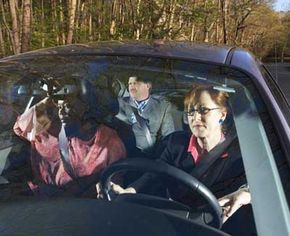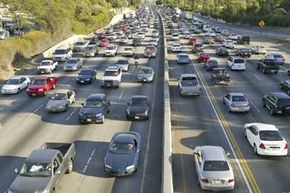Commuters can take advantage of many carpool benefits. Perhaps one of the most important benefits to commuters is that carpooling saves money. Sticker shock at the gas pumps has many people trying to cut down on the amount of fuel they use -- joining a carpool is a great way to share the energy burden. Other vehicle-related savings shouldn't be overlooked either. If you have a long commute, the wear and tear on your car can really add up.
Sharing the cost of gas isn't the only way carpoolers save money. Many organizations, like the Clean Air Campaign, offer reward programs to local carpoolers. You can log your carpool commute with these organizations and get cash in your wallet. Some insurance companies offer discounts to people who rideshare, and sometimes carpoolers receive access to special parking spots.
Another big reason folks are starting to carpool more is traffic congestion. The more cars on the road, the worse congestion gets. If people can fill the empty seats in their cars with other riders, the smoother the drive becomes for everyone. Local economies also benefit from less traffic congestion. Good traffic flow is one of the deciding factors when companies look to relocate or expand in certain cities.
Leaving the car at home once in a while helps to decrease levels of air pollution. These levels can be especially high in urban, traffic-congested areas.
Concerns carpoolers should keep in mind are some of the new initiatives created to help calm traffic in some cities. Some of these initiatives seek to transform underused High Occupancy Vehicle (HOV) lanes to High Occupancy Toll (HOT) lanes in an attempt to tackle gridlock and move traffic.
Some cities are converting HOV lanes into HOT lanes, then charging tolls to use these lanes. Different places settle on different formulas, but generally, buses and vanpools can zip past electronic tolls without paying anything. Even three-person carpools might be able to get through. But two-person carpools and single drivers might be charged to use the lane.
The tricky part is, as the level of traffic increases, so does the toll fee. Cars are alerted to the current charge at the lane's entrance, regulating the amount (and therefore speed) of traffic in the HOT lane. A single driver in rush hour pays more to use the lane than a car with two people at rush hour and more than a driver who accesses the lane in the middle of the night. The goal is to keep that lane's traffic moving and allow people the option to use the lane if they're willing to pay. This helps to balance the level of traffic in all the lanes.
People who carpool with multiple members will be ahead of the game if HOT lanes start popping up in their city, but two-person carpools may want to add members. People who live in cities with these controversial HOT lanes seem to cough up the money, and in return, these commuters get a more reliable trip time.
If you want to add some company during your commute by starting a carpool, visit the links on the next page.

